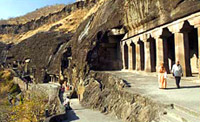 Maharashtra is a demesne of Maratha rulers who left an indelible mark of majesty and exuberance in the heritage of culture of Madhya Pradesh. The Chalukyas, Satavahanas, as well as Delhi sultanates too enriched the culture of Maharashtra with the vivacity and vigour and it had lead Maharashtra to stand apart from the rest of India. It is a land of temples, which are also examples of refined works of architecture. The tourists all over the world are bewitched by the aesthetic charm of Ajanta and Ellora caves. The uniqueness of Maharashtra is the perfect co-mingling of the cultural tradition of both the Hindu and Muslim dynasties. Vitthala Temple, situated, at Pandharpur is highly revered by the Hindu devotees. Exquisite fortresses, namely Raigad and Pratapgad and also the sea forts including Sindhudurg fort embellishes the entire region. Musical fervor, enigmatic dance, fantabulous foods and lifestyle of Maharastrians truly embody the magnanimity of royal families. Folk society too had a share in enriching the cultural ebullience of Maharashtra.
Maharashtra is a demesne of Maratha rulers who left an indelible mark of majesty and exuberance in the heritage of culture of Madhya Pradesh. The Chalukyas, Satavahanas, as well as Delhi sultanates too enriched the culture of Maharashtra with the vivacity and vigour and it had lead Maharashtra to stand apart from the rest of India. It is a land of temples, which are also examples of refined works of architecture. The tourists all over the world are bewitched by the aesthetic charm of Ajanta and Ellora caves. The uniqueness of Maharashtra is the perfect co-mingling of the cultural tradition of both the Hindu and Muslim dynasties. Vitthala Temple, situated, at Pandharpur is highly revered by the Hindu devotees. Exquisite fortresses, namely Raigad and Pratapgad and also the sea forts including Sindhudurg fort embellishes the entire region. Musical fervor, enigmatic dance, fantabulous foods and lifestyle of Maharastrians truly embody the magnanimity of royal families. Folk society too had a share in enriching the cultural ebullience of Maharashtra.
Arts of Maharashtra
Maharashtrian people have achieved high expertise in the fine art and craft finishes. The fine fabrics of mashru and himroo are the clear examples of their highest level of weaving art. The fabrics which look like golden cloth are regarded to be one of the finest of its kind. The high level weaving know-how are also evident with the paithani and narayan peth sarees. Hand-made leather chappals and sandals of Kolhapur district of Maharashtra are world famous. - Most of the Maharashtrian jewelleries are derived from the legacies of Maratha and Peshwa dynasties. Kolhapur is famous for its special type of necklace called Kolhapur saaj. Himroo, also known as kum khuab is a distinctive, luxurious fabric, once used as dress material by the nobles of the olden days. The district of Aurangabad is popular because of these fine fabrics. Narayan Peth saree is very much popular in and around Sholapur district of Maharashtra. It is a traditionally Maharashtrian saree -. Paithani saree took its name from a place called Paithan, where it started producing 2000 years ago. This saree is made of silk with an ornamented zari pallav and border. Warli paintings are the tribal wall paintings of the warli tribes of Maharashtra.
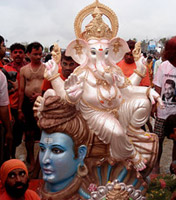 Festivals of Maharashtra
Festivals of Maharashtra
Maharashtra has been bestowed the status of being cultural capital and no doubt, the culture of Maharastra largely becomes robust by festivals and its lavish celebrations. Diwali, Holi, Dusshera, Nava Ratri are feted in excellence. There are few local festivals whose celebrations are being done by the localities with great festivities. Ganeshotsav is the main festival. It is mostly observed from `Ganesh Chaturthi` to `Anant Chaturdashi`. The festival commemorates the worship of Ganesha, who is regarded as the deity of learning and knowledge. A large number of people travel in their foot, hundreds of kilometers, to Pandharpur for the annual pilgrimage in the month of Ashadh.
Gudi Padwa is observed on the first day of the month of Chaitra, thereby signaling the arrival of the most cherished spring, the season of colour and joy. Maharashtrians feted it as the New Year day. Gudi Padwa is consecrated to the worship of Lord Brahma. Many legends state that this festival is celebrated to mark the victory of Rama over Bali. It symbolizes a new beginning thus cleansing away all the negativities and wrong doings of the previous year. It is the time of family get-together. Maharashtrian s decked up in new attires and wholeheartedly engulf with the fun and frolic of the festival fiesta.
Holi is observed and myriads of people indulge themselves in this festival of colors. In Maharashtra, Rangapanchami takes place a couple of days later on a `Panchami`(fifth day of the full moon), indicating the end of festival fete.
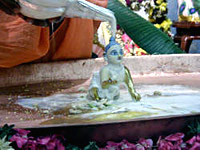 Gokulashtami, or Janmaashtami, is also known as Dahi Handi The festival is observed, in éclat, in the months of August or September. Various Handis are hung up in almost every of the city. Groups of young people called Govinda Pathaks personified as companions of Lord Krishna move around the city in trucks throughout the day and burst the handis .
Gokulashtami, or Janmaashtami, is also known as Dahi Handi The festival is observed, in éclat, in the months of August or September. Various Handis are hung up in almost every of the city. Groups of young people called Govinda Pathaks personified as companions of Lord Krishna move around the city in trucks throughout the day and burst the handis .
Music and Dance of Maharashtra
Music and dance are part and parcel of the culture of Maharashtra. The airs of folk music like Gondhal, Lavani, Bharud, Powada enrapture the people. Lavani encompasses both dance and music and is performed enthusiastically by the artists in accompaniment with a special musical drum called Dholak
.
Povadas is a type of Marathi ballad, depicting various aspects of life of the great Maharashtrian leader, Sri Chhatrapati Shivaji Maharaj. The culture of Maharashtra nicely breeds various enamoring dance forms. Dhangars or shepherds of Sholapur district of Maharashtra execute a special dance form called Dhangari Gaja. The dancers practise this dance form to appease Gods and seek their blessings. In Maharashtra, a fishermen community called Koli performs a dance of the same name. Both men and women take part imitating the movements of boat rowing, net casting etc. Apart from these, few dance forms of religious folk dance genre have evolved. Dindi is such a dance, which is generally executed during Ekadashi day in Kartik month. Kala is another example of the same type. This dance form boasts a pot representing prolificacy.
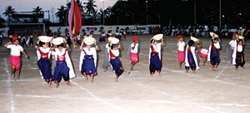
Cuisine of Maharashtra
Maharashtrians savor delicious foods and the cuisine became an indispensable element of the culture. Within Maharashtra it diverges as per different areas. For Konkanis, rice is staple food; fish, different types of vegetables, is chiefly savored by the people living in the coastal region. Peanuts and cashew nuts are widely used in vegetables. In eastern part of Maharashtra, the diet is composed of wheat, Jowar and Bajra. Lentils, onions, tomatoes chicken and mutton are eatables savored by almost all the city dwellers of Maharashtra. Coconut is an integral component of Maharashtrian cuisine.
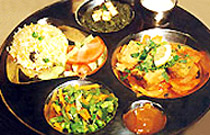 However instead of using coconut oil as a cooking medium, the people prefer peanut oil as the main cooking medium. A typical Maharashtrian meal usually ends with delicious desserts. Famous `puran poli` is a special one prepared by stuffing roti with a sweet mixture of jaggery and gram flour and is served at the time of the Maharashtrian New Year. Other popular sweets are the ukdiche modak, the panpole ras and the shreekhand.
However instead of using coconut oil as a cooking medium, the people prefer peanut oil as the main cooking medium. A typical Maharashtrian meal usually ends with delicious desserts. Famous `puran poli` is a special one prepared by stuffing roti with a sweet mixture of jaggery and gram flour and is served at the time of the Maharashtrian New Year. Other popular sweets are the ukdiche modak, the panpole ras and the shreekhand.
Language of Maharashtra
Main languages of Maharashtra are Marathi, Hindi and English. Marathi and Hindi are mostly understood all over the state but different regions have their own dialects. Marathi script does not have any silent pronunciation making the language so phonetic. Konkani is also spoken in some areas of Maharashtra. Other major dialects include Varhadii spoken in the Vidarbha region and Dangii spoken near Maharashtra-Gujarat border. Alphabet `L` is abundantly used in many verbs and nouns in Marathi. It is replaced by the letter `y` in the Varhadii dialect, which makes it quite distinct.
Tribes of Maharashtra
According to 1991 census, nomadic tribes constitute about 73.18 lakhs in Maharashtra. They are spread over in large areas, mainly on hilltops. Bhil, Gond-Madia, Katkari, Koli, Oraon, Warli are the major tribes of Maharashtra. A greater part of the tribes still follows the primitive characters. They live in groups moving from one place to another in caravans in search of livelihood. As they keep on wandering from one place to other, these tribes are in lack education, which makes their survival difficult.
Lifestyle of Maharashtra
The culture of Maharashtra is indebted to its rich heritage of entertainment industry. The theatre, television, movies are indispensable for a Maharashtrian. Mumbai is the nub of Indian film and entertainment industry. Dadasaheb Phalke is the father of Indian films; numerous actors, singers, directors of different times followed his footsteps. Maratha theatre too is highly exponential. It is also a place of historical treasures. Beautiful monuments and palaces nicely enmeshed with the scenic beauty of striking Western ghats, serenity of mighty rivers and the tourists naturally frequent various places of Maharashtra. The tomb of the wife of Aurangzeb, popularly known as `Bibi Ka Maqbara`, is a fantastic instance of Mughal architecture. Also the region is a commercially viable and innumerable trader and businessmen mobbed the cities like Mumbai, Pune etc.
Maharashtra has got a cosmopolitian outlook. Hindus, Muslims, and a small percantage of other minority communities like buddhists, Jains, Christians enjoy their peaceful stay in the region of Madhya Pradesh. Marathi is the official state language and is widely spoken by the majority of the people.
The culture of Maharashtra is glittered by the literary extravaganza and the number of Marathi exponents is pretty large. In fact, Marathi literature is enriched in its content and style of Bhawarthadeepika written by Dnyaneshwar, one of the primitive instances of Marathi literature. Modern Marathi literature is also thronged by great poets and authors like P. L. Deshpande, Kusumagraj, Prahlad Keshav Atre.
Traditional Dresses of Maharashtra
The occupation of the majority of people in Maharashtra is agriculture. People living on the Konkan Coast- the Konkanis are involved in fishing. Both of these activities require a lot of labour work. The people are to work hours in the sun and move around from one place to the other. Thus they wear clothes that made it easier for them to do so. Men in Maharashtra usually wear a dhoti. A dhoti is a single piece of cloth that is tucked around one`s waist, and it covers the entire leg till the ankle. Dhotis are secured by making five tucks on each side, and then the loose ends are put in at the back. Dhotis are usually saffron or cream or white in colour. Men wear Pehta or a head cover usually made up of cotton. It is also known as pagris are small hats that are made to cover the heads so as to protect them from the direct sun rays falling on their heads. Maharashtrian men usually wear cotton tops or Kurtas above their dhoti. The tops are made up of cotton so as to able the garment to absorb sweat since Maharashtra has a warm to a hot environment. They occasionally wear waistcoat called Bandi which is a sleeveless jacket or coat.
Women wear sarees that are 9 yards long. The saree is tucked in the middle giving it a similar look to the dhoti. The rest of the saree is wrapped around the upper body of the women. This type of saree is usually called Lugade. There were many variations in how women wear their saree. Some only wear knee length sarees. Some wear it in a skirt manner without the tuck in the middle. Women do not have a separate headwear as the men do. They simply use the end of their sarees to cover their heads. The Maharashtrian women wear choli or blouse underneath the saree. It is the `top` or shirt that they wear to cover their upper body. The choli covers half of the torso. Women wear nath i.e. a nose piercing. Naths can be simple loops or loops connected with the earring on any one side. They are normally made up of gold. Women are also found wearing other gold jewellery like earrings and necklace (haar) with different coloured stones. Married women wear mangal sutra and also green bangles. The bride wears green bangles as they are said to bring prosperity to the relationship and family. Some women even wear toe rings on their second toe of both of their feet.
The Kolhapuri chappals are open-toed sandals in a t-strap shape that are handmade by the Maharashtrian from leather and are tanned using vegetable dyes. Kolhapuri chappal originated in the Kolhapur District of Maharashtra and are worldly known for its strength and endurance. Maharashtrians seem to have the same style of attire for everything they do - whether it is resting or attending a wedding or travelling. The only thing that differs is the material. Cotton is used for making attires for all occasions and is cheap whereas silk is relatively expensive and used for making garments for weddings, festivals and other such events.
Literature of Maharashtra
Maharashtra`s regional literature is about lives and circumstances of Marathi people in specific parts of the state. The Marathi language, which boasts a rich literary heritage, is written in the Devanagari script. The earliest instances of Marathi literature is by Sant Dnyaneshwar with his Bhawarthadeepika (popularly known as Dnyaneshwari). The compositions, written in the 13th century, are spiritually inclined. Other compositions are by Bhakti saints such as Tukaram, Eknath, Namdev, Ramdas, and Gora Kumbhar. Their compositions are mostly in poetic form, which are called Abhang. Maharashtra has a long tradition in spiritual literature, evidenced by the Amrutanubhav, Bhavarth Deepika, Bhagavata Purana, Eknathi Bhagwat and Bhavarth Ramayan.
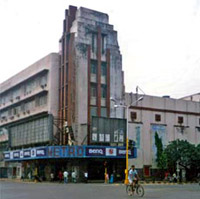 19th century Marathi literature includes the works of authors such as Balshastri Jambhekar, Gopal Ganesh Agarkar, Bal Gangadhar Tilak, Gopal Hari Deshmukh, Mahadev Govind Ranade, Jyotirao Phule, Babasaheb Ambedkar, Vinayak Damodar Sawarkar, Ram Ganesh Gadkari, Tryambak Bapuji Thombre, Hari Narayan Apte, Vishnushastri Chiplunkar and Keshavsuta. 20th century notable writers include Mahadevshastri Joshi, Kusumagraj, Pu La Deshpande, Va Pu Kale, Vyankatesh Digambar Madgulkar, Vishnu Sakharam Khandekar, Prahlad Keshav Atre, B. S. Mardhekar, Sane Guruji, Vinoba Bhave, Chintamani Tryambak Khanolkar, Bahinabai Chaudhari and Laxmanshastri Joshi, Vishwas Patil, Ranjit Desai, Shivaji Sawant, Narayan Surve, Vinda Karandikar, Shanta Shelke, Durga Bhagwat, Suresh Bhat, Ratnakar Matkari, Varjesh Solanki, Manya Joshi, Hemant Divate, Mangesh Narayanrao Kale, Avinash Dharmadhikari, Bhalchandra Nemade, Narendra Jadhav and Saleel Wagh are some of the more recent authors. Regional languages spoken in Maharashtra are Kokani, Koli, Malvani, Varhadi and Khandeshi.
19th century Marathi literature includes the works of authors such as Balshastri Jambhekar, Gopal Ganesh Agarkar, Bal Gangadhar Tilak, Gopal Hari Deshmukh, Mahadev Govind Ranade, Jyotirao Phule, Babasaheb Ambedkar, Vinayak Damodar Sawarkar, Ram Ganesh Gadkari, Tryambak Bapuji Thombre, Hari Narayan Apte, Vishnushastri Chiplunkar and Keshavsuta. 20th century notable writers include Mahadevshastri Joshi, Kusumagraj, Pu La Deshpande, Va Pu Kale, Vyankatesh Digambar Madgulkar, Vishnu Sakharam Khandekar, Prahlad Keshav Atre, B. S. Mardhekar, Sane Guruji, Vinoba Bhave, Chintamani Tryambak Khanolkar, Bahinabai Chaudhari and Laxmanshastri Joshi, Vishwas Patil, Ranjit Desai, Shivaji Sawant, Narayan Surve, Vinda Karandikar, Shanta Shelke, Durga Bhagwat, Suresh Bhat, Ratnakar Matkari, Varjesh Solanki, Manya Joshi, Hemant Divate, Mangesh Narayanrao Kale, Avinash Dharmadhikari, Bhalchandra Nemade, Narendra Jadhav and Saleel Wagh are some of the more recent authors. Regional languages spoken in Maharashtra are Kokani, Koli, Malvani, Varhadi and Khandeshi.
Tourism in Maharashtra
Maharashtra is synonymous to Mumbai, its capital city that is known for its pulsating rich lifestyle that never comes to down still. And Mumbai is the nexus of the prolific global film industry - Bollywood; that`s what exactly charms tourists the most. Mahabaleshwar, Panchgani, Matheran, Mhaismal, Lonavala, Khandala, Amboli, and Malshej Ghat are the famous summer getaways of Maharashtra, and they are accessible too. Most of them must be having the similar silhouette, but each has its unique characteristic charm, charisma, and allure. Besides the hill stations, the eastern region of Maharashtra has some of the most promising national parks, where there are chances to spot tigers and many other mammals and birds. All in all, there are six wildlife reserves in Maharashtra that attracts an impressive range of animals, including Crocodiles, Bisons, Gawas, Neelgais, and numerous other avian species. Amongst all these parks, the must visit for wildlife tours are Tadoba National Park and Navegaon National Park, which keeps on buzzing with tourists even in the offseason to seek relaxation, and jeep safaris. Since all the hill stations and jungles of the Maharashtra are quite pristine, so to explore all these hidden gems, travelers are often seen heading to these places to take part in treks like Torna Trek, Raigad Trek, Visapur Fort Trek, Shivneri Trek, Harishchandragad Trek, Lohgad Trek, Kalsubai Peak Trek, Vasota Fort Trek, to name a few. Apart from trekking, rafting, caving, and paragliding are some of the activities that keep one on their toes and leave their hearts filled with thrill and elation. To further add a little thrill to the adventure vacation, one can sign up for a white water rafting over river Kundalika, near the western ghats.



















